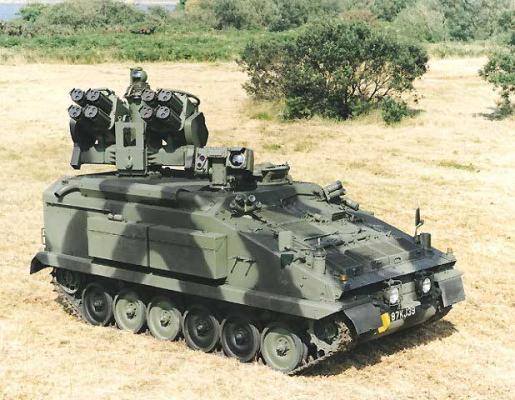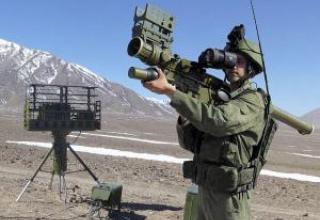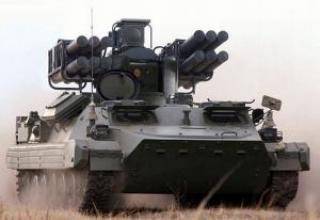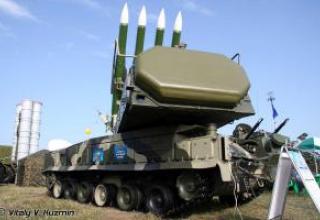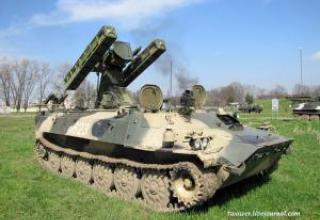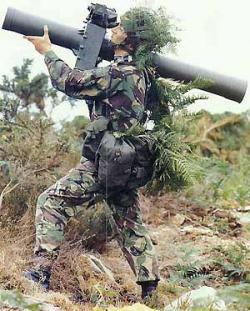
Anti-aircraft missile system "Starstreak" is designed to engage a wide range of airborne attack vehicles, including supersonic aircraft and low-flying attack helicopters to the point where they effectively use their weapons.
The "Starstreak" complex is designed in three versions: portable SAM (SL), wearable on the basis of lightweight multi-charge launcher (LML) and self-propelled on armored landing gear "Stormer" (SP). The latter option is designed to provide air defense for armored units.
The main developer of the Starstreak complex is Thales Air Defence Ltd (formerly Shorts Missile Systems). Besides it, the following companies take part in the development and production of the complex: GKN Defence (armoured chassis Stormer), Avimo (sighting and optical system), Racal Instruments (test and verification equipment), Hunting Engineering (launcher), BAe RO (rocket engine and fuse), BAe Systems (gyroscope unit and data bus), Marconi Avionics. In July 2001, a contract was signed with the French company Thales Communications for the development of a system of identification "in-situ".
Officially, the Starstreak anti-aircraft missile system was adopted by the British Army on September 1, 1997, a modified multi-charge launcher - in 2000. Since 1998 the complex in SP version is exported. In 2003, Thales Air Defence Ltd. won the tender to supply the Starstreak SAM system to the South African armed forces for the total amount of over 20.6 million Euro. The contract is implemented within the framework of the South African program for the modernization of ground-based air defense forces.
Modification of the Starstreak missile - an air-to-air missile of Helstreak class. In September 1988, the firm "Shorts" concluded an agreement on equipping the AH-64 "Apache" helicopter with close combat missile weapons. This system called "Helstreak" consists of one or more twin airborne missile launchers (weighing 50 kg each) and a guidance system transmitter. The Helstreak rocket has also adapted to other helicopters.
In 1991, a variant of the Starstreak complex was presented for use on a marine multistart system. Two launchers, three missiles each, can be serviced from one workstation.
Composition:
All variants of the complex use a single rocket "Starstreak HVM" (High Velocity Missile), which is located in a unified transport and launch container. The missile is equipped with a two-stage solid propellant engine. Distinctive feature of the missile is the original combat unit, which consists of three arrow-shaped spears and their breeding system. Each spear (spear length - 0.45m, diameter - 0.02m) has its own control and guidance loop on the laser beam, thermopile, armor-piercing core and explosive charge. After breeding the spears are lined up in a triangular battle order around the laser beam. Due to the high speed of flight, the spear penetrates the target body and then explodes inside it with maximum damage. At full range, the spears have sufficient maneuverability to destroy targets flying with an overload of 9g. The warranty period of the missile's combat capability is 10 years.
The sighting unit includes a light-alloy hermetic optical sight with a stabilized laser system and a monocular sight, as well as a hermetic control unit placed in a cast form, which contains a power source (with one lithium-sulfide battery) and electronic units necessary for data processing and control.
The control unit has a joystick, trigger, common switch, wind compensation switch and a height meter. During the battle, the gunner grips the target with his monocular sight and charges the sighting unit from the power supply. The reticle is located in the centre of the gunner's field of view, which holds the selected target in the crosshairs of the reticle. Azimuth and angle warning ensure that the missile will destroy the target by hitting the rear hemisphere as well.
After the pre-launch gripper operation is complete, the gunner presses the trigger mechanism. The launch accelerator is launched from the power source. The rocket takes off from the PIC, the starter motor is switched off. The accelerator accelerates the missile to a high speed so that it has enough rotation to create a centrifugal force that deploys stabilizers. The Accelerator is separated from the missile after its departure from the PIC at a safe distance from the shooter, the main engine is switched on in less than a second of flight and accelerates the missile to speeds in the range from MoH to M4. After the main engine is switched off, three lances are automatically fired at the speed sensor signal. The arrow-shaped spears are guided by the laser beam formed by the sighting unit using two laser diodes, one of which scans in the horizontal plane and the other in the vertical plane.
After starting, the operator continues to combine the target with the reticle using the joystick. According to some reports, the introduction of additional software makes it possible to hold the angle meter on the target automatically. After the gun is fired, the operator will attach a new one to the sighting unit instead of an empty one.
Self-propelled variant of SP complex (variants of placing on the chassis of "Stormer", M113, "Piranha") has 8 starting containers, located in two packages of four, and is equipped with infrared passive system of detection and tracking of targets ADAD ("Air Defence Alerting Device") of Thales Optronics ("Pilkington Optronics"). The range of detection of an airplane type target is about 18 km, and a helicopter type target is 8 km. The time interval between target detection and missile launch is less than 5 seconds. Portable ammunition - 12 missiles. The vehicle is equipped with satellite communication and satellite navigation systems (see photo).
There is also a known variant of placing the Starstreak complex with a reduced (up to four) number of launch containers (see photo) on the chassis of the cross-country vehicle (see photo 1, photo 2).
Modified lightweight multi-charger LML launcher (see photo) consists of three standard Starstreak complexes, located "at traffic lights" (vertically). The portable sighting unit is mounted on a rotary device, which can be quickly turned 360 degrees. The launcher can receive target designation from the ADAD system or external detection radar, is equipped with the "own" identification system and "Starlite" infrared sight, which provides the possibility of round-the-clock application of the complex. Weight of tripod - 16 kg, sighting unit - 19.5 kg, tracking system - 9 kg, infrared sight - 6 kg. The missiles can be launched in less than 9 seconds from the moment of target detection, all three missiles can be launched in less than 2 minutes.
The complex can be operated at temperatures from -30° to +60° C.
Characteristics:
| Defeat range, km | 0.3 - 6 |
| Defeat height, km | 5 |
| Maximum missile speed, M | 3-4 |
| Flight time to a range of 3 km, s | 3.5 |
| The length of the rocket, mm | 1369 |
| The weight of the rocket, kg | 14 |
Sources:
- "Starstreak" close air defence missile system UNITED KINGDOM
- "Thales-airdefence"
- Василин Н.Я., Гуринович А.Л. "Зенитные ракетные комплексы" .-Мн.: ООО "Попурри", 2002- 464с.
- "Starstreak" close air-defence missile system (www.bdec-online.com)
- High Velocity Missile (HVM) Starstreak
- Starstreak HVM
- Starstreak

